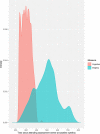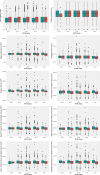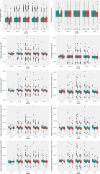Investigating the synergistic effects of hormone replacement therapy, apolipoprotein E and age on brain health in the UK Biobank
- PMID: 38339898
- PMCID: PMC10836173
- DOI: 10.1002/hbm.26612
Investigating the synergistic effects of hormone replacement therapy, apolipoprotein E and age on brain health in the UK Biobank
Abstract
Global prevalence of Alzheimer's Disease has a strong sex bias, with women representing approximately two-thirds of the patients. Yet, the role of sex-specific risk factors during midlife, including hormone replacement therapy (HRT) and their interaction with other major risk factors for Alzheimer's Disease, such as apolipoprotein E (APOE)-e4 genotype and age, on brain health remains unclear. We investigated the relationship between HRT (i.e., use, age of initiation and duration of use) and brain health (i.e., cognition and regional brain volumes). We then consider the multiplicative effects of HRT and APOE status (i.e., e2/e2, e2/e3, e3/e3, e3/e4 and e4/e4) via a two-way interaction and subsequently age of participants via a three-way interaction. Women from the UK Biobank with no self-reported neurological conditions were included (N = 207,595 women, mean age = 56.25 years, standard deviation = 8.01 years). Generalised linear regression models were computed to quantify the cross-sectional association between HRT and brain health, while controlling for APOE status, age, time since attending centre for completing brain health measure, surgical menopause status, smoking history, body mass index, education, physical activity, alcohol use, ethnicity, socioeconomic status, vascular/heart problems and diabetes diagnosed by doctor. Analyses of structural brain regions further controlled for scanner site. All brain volumes were normalised for head size. Two-way interactions between HRT and APOE status were modelled, in addition to three-way interactions including age. Results showed that women with the e4/e4 genotype who have used HRT had 1.82% lower hippocampal, 2.4% lower parahippocampal and 1.24% lower thalamus volumes than those with the e3/e3 genotype who had never used HRT. However, this interaction was not detected for measures of cognition. No clinically meaningful three-way interaction between APOE, HRT and age was detected when interpreted relative to the scales of the cognitive measures used and normative models of ageing for brain volumes in this sample. Differences in hippocampal volume between women with the e4/e4 genotype who have used HRT and those with the e3/e3 genotype who had never used HRT are equivalent to approximately 1-2 years of hippocampal atrophy observed in typical health ageing trajectories in midlife (i.e., 0.98%-1.41% per year). Effect sizes were consistent within APOE e4/e4 group post hoc sensitivity analyses, suggesting observed effects were not solely driven by APOE status and may, in part, be attributed to HRT use. Although, the design of this study means we cannot exclude the possibility that women who have used HRT may have a predisposition for poorer brain health.
Keywords: APOE; UK Biobank; ageing; cognition; hormone replacement therapy; neuroimaging.
© 2024 The Authors. Human Brain Mapping published by Wiley Periodicals LLC.
Conflict of interest statement
The authors declare no conflicts of interest.
Figures



Similar articles
-
Menopausal hormone therapy and the female brain: Leveraging neuroimaging and prescription registry data from the UK Biobank cohort.Elife. 2025 May 29;13:RP99538. doi: 10.7554/eLife.99538. Elife. 2025. PMID: 40439116 Free PMC article.
-
Apolipoprotein E genotype and response of lipid levels to postmenopausal estrogen use.Atherosclerosis. 2002 Mar;161(1):209-14. doi: 10.1016/s0021-9150(01)00632-3. Atherosclerosis. 2002. PMID: 11882334
-
Age, sex, and apolipoprotein E isoform alter contextual fear learning, neuronal activation, and baseline DNA damage in the hippocampus.Mol Psychiatry. 2023 Aug;28(8):3343-3354. doi: 10.1038/s41380-023-01966-8. Epub 2023 Feb 2. Mol Psychiatry. 2023. PMID: 36732588 Free PMC article.
-
The Relationship Between Physical Activity and Non-Modifiable Risk Factors on Alzheimer's Disease and Brain Health Markers: A UK Biobank Study.J Alzheimers Dis. 2024;101(4):1029-1042. doi: 10.3233/JAD-240269. J Alzheimers Dis. 2024. PMID: 39269836 Free PMC article. Review.
-
APOE in the bullseye of neurodegenerative diseases: impact of the APOE genotype in Alzheimer's disease pathology and brain diseases.Mol Neurodegener. 2022 Sep 24;17(1):62. doi: 10.1186/s13024-022-00566-4. Mol Neurodegener. 2022. PMID: 36153580 Free PMC article. Review.
Cited by
-
Menopausal hormone therapy and the female brain: leveraging neuroimaging and prescription registry data from the UK Biobank cohort.medRxiv [Preprint]. 2025 Jan 14:2024.04.08.24305450. doi: 10.1101/2024.04.08.24305450. medRxiv. 2025. Update in: Elife. 2025 May 29;13:RP99538. doi: 10.7554/eLife.99538. PMID: 38645009 Free PMC article. Updated. Preprint.
-
Menopausal hormone therapy is associated with worse levels of Alzheimer's disease biomarkers in APOE ε4-carrying women: An observational study.Alzheimers Dement. 2025 Feb;21(2):e14456. doi: 10.1002/alz.14456. Epub 2025 Jan 9. Alzheimers Dement. 2025. PMID: 39783876 Free PMC article.
-
Menopausal hormone therapy and the female brain: Leveraging neuroimaging and prescription registry data from the UK Biobank cohort.Elife. 2025 May 29;13:RP99538. doi: 10.7554/eLife.99538. Elife. 2025. PMID: 40439116 Free PMC article.
References
-
- Alfaro‐Almagro, F. , Jenkinson, M. , Bangerter, N. K. , Andersson, J. L. R. , Griffanti, L. , Douaud, G. , Sotiropoulos, S. N. , Jbabdi, S. , Hernandez‐Fernandez, M. , Vallee, E. , Vidaurre, D. , Webster, M. , McCarthy, P. , Rorden, C. , Daducci, A. , Alexander, D. C. , Zhang, H. , Dragonu, I. , Matthews, P. M. , … Smith, S. M. (2018). Image processing and Quality Control for the first 10,000 brain imaging datasets from UK Biobank. NeuroImage, 166, 400–424. 10.1016/j.neuroimage.2017.10.034 - DOI - PMC - PubMed
MeSH terms
Substances
Grants and funding
LinkOut - more resources
Full Text Sources
Medical
Miscellaneous

